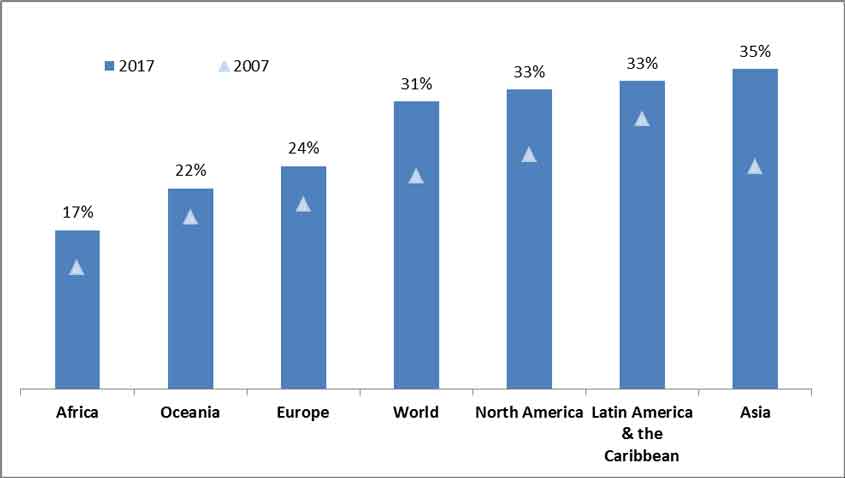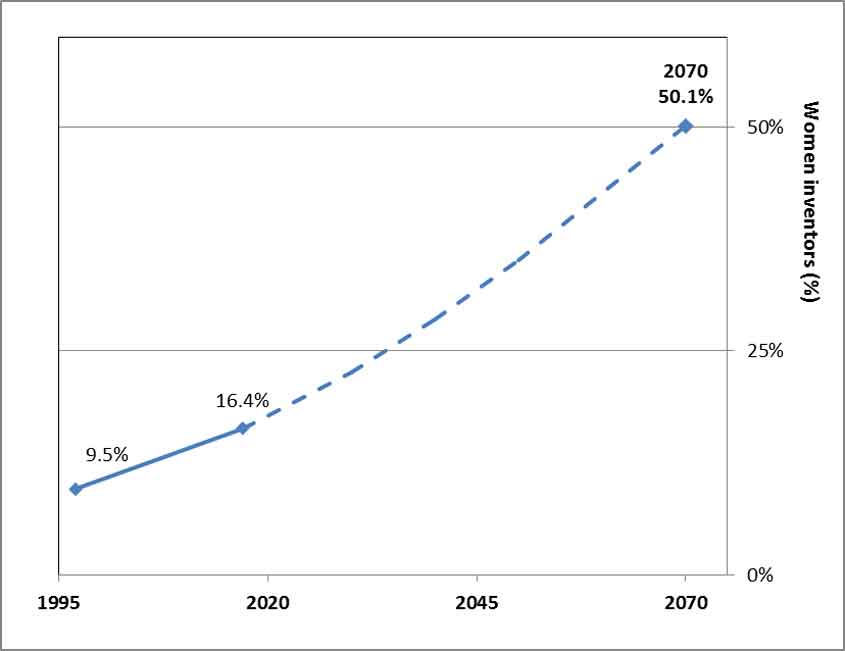
Women and the international patent system: encouraging trends
By Bruno Lefeuvre and Julio Raffo, Economics and Statistics Division, Kaori Saito, Gender and Diversity Specialist, WIPO, and Gema Lax-Martinez, University of Lausanne, Switzerland
Women contribute to all fields of creativity and intellectual endeavor, yet their achievements often remain hidden from view.
The gender gap is all-pervasive. Even in advanced economies, women come up against the infamous “glass ceiling,” finding it hard to climb to the top; and if they do, they are often paid less than their male counterparts. The gender gap is also evident in education. Although progress is being made in encouraging girls to take up so-called STEM (scientific, technical engineering and mathematical) subjects, and many go on to obtain first and second degrees in those subjects, few of them enroll in or graduate from PhD programs.
If we track women throughout their career as scholars or inventors, the gap expands further. Proportionally fewer women graduating with PhDs take up research work. When they do, they earn less and have a hard time moving up the hierarchy. Evidence also shows that the share of women publishing scientific papers is lower than those employed as researchers. In turn, the proportion of women using the patent system remains low compared with the proportion of scientific papers they publish each year. Some scholars refer to this pattern as the “leaky pipeline.”
Recognizing the scale of this gender imbalance, the United Nations General Assembly and its 193 member states adopted the 2030 Agenda for Sustainable Development. That Agenda took effect on January 1, 2016. It underscores that gender equality and the empowerment of women and girls will contribute to progress across all the Sustainable Development Goals and targets.
As a specialized agency of the United Nations, the World Intellectual Property Organization (WIPO) is committed to promoting gender equality in the field of intellectual property and has taken steps to raise the profile of gender equality, and indeed, mainstream it, within the day-to-day running of the Organization. These steps include the disaggregation of intellectual property (IP) data by gender as a key performance indicator for policies aimed at promoting innovation and creativity and spurring economic, social, and cultural development.
To achieve this objective, WIPO compiled a worldwide gender-name dictionary which includes 6.2 million names for 182 different countries, with a view to identifying the gender of inventors, designers and other IP users. WIPO maintains and periodically updates this dictionary to increase the global scope of its IP and gender statistics. Research and statistics on patents and gender are reported annually (see the PCT Yearly Review and the World Intellectual Property Indicators).

WIPO’s data on patents and gender reveal a very encouraging trend. Gender participation in the IP system is improving. Virtually all indicators related to gender balance in WIPO’s Patent Cooperation Treaty (PCT) or patent system as a whole show some degree of progress in recent decades. This progress is observed in most countries, in all technical fields and in both academic institutions and companies, although at different rates.
All regions of the world have observed an increase in the share of PCT applications with at least one woman inventor named in the application initially filed with a patent office, the so-called “country of origin.” Asia, North America, and Latin America and the Caribbean outperform the global average.
Standard economic performance indicators such as GDP per capita do not explain the gender gap. Many middle-income countries, such as Brazil and Mexico, have a better gender balance in international patenting than some high-income countries, such as Canada, Denmark, and Finland. In contrast, Germany, Italy, Japan, and South Africa have the greatest gender gap among the top listed origins.
The participation of women in the international patent system varies across technological fields. This explains, in part, the regional and national differences. Technologies related to the life sciences are often among the most gender-balanced fields. Women are more likely to patent in biotechnology (58 percent of international applications have at least one woman inventor), pharmaceuticals (56 percent), organic fine chemistry (55 percent), and food chemistry (51 percent). Conversely, engineering and mechanical-related technologies are among the least gender-balanced. Very few women participate in patents related to mechanical elements (14 percent), engines (15 percent), civil engineering (15 percent), machine tools (16 percent), or transport (17 percent).
The participation of women also varies between the public and private sectors. Universities and public research organizations have a higher share of PCT applications featuring women inventors than the business sector. In 2017, around 51 percent of all PCT applications filed by the academic sector included women inventors, compared to only 30 percent for the business sector. But although the academic sector has the highest participation rate for women, the business sector accounts for the largest absolute number of women inventors.

Within the private sector, the majority of the top PCT applicants saw an increase in the share of PCT applications with women inventors. Those with higher levels of participation by women inventors include LG Chemical, Hoffman-La Roche, L’Oréal, Dow Global Technologies, Henkel, Procter & Gamble, Samsung Electronics, and BOE Technology. The more gender-balanced academic institutions include the Electronics & Telecommunications Research Institute of Korea and Shenzhen Institute of Advanced Technology of China. Outside China and the Republic of Korea, we observe higher participation of women inventors from Tel Aviv University (Israel), the Agency of Science, Technology and Research (Singapore), the Consejo Superior de Investigaciones Cientificas (Spain), and the Institut National de la Santé et de la Recherche Medicale (France).
Notwithstanding the positive upward trend in the participation of women inventors in the international patent system relative to men, the picture remains far from balanced. Assuming current progression rates, we will not see gender balance in patenting until 2070.
However, the participation of women in patenting is not equally distributed across countries or regions, nor is it equal in absolute terms. In this sense, women patenting in Germany, Japan, and the United States are expected to determine the global progression of gender balance to a great extent in the following decades. Similarly, while some technology fields show more progress than others, patenting in those fields may also be growing faster than others. The growth in patenting in the life sciences and ICT-related technologies, for example, will influence gender balance in future years. Finally, policies that successfully promote gender balance in the business sector – which is responsible for filing the bulk of patent applications – may have greater impact on the overall gender balance than those implemented in academia.
Ultimately, however, gender balance in the patent system is likely to come about as a result of a long social process that accumulates balances and imbalances from previous institutional settings. The nature of the evolution of gender balance in different scientific fields, higher education institutions and the most innovative industries around the world will inevitably shape the gender balance of the international IP system in the future.
The WIPO Magazine is intended to help broaden public understanding of intellectual property and of WIPO’s work, and is not an official document of WIPO. The designations employed and the presentation of material throughout this publication do not imply the expression of any opinion whatsoever on the part of WIPO concerning the legal status of any country, territory or area or of its authorities, or concerning the delimitation of its frontiers or boundaries. This publication is not intended to reflect the views of the Member States or the WIPO Secretariat. The mention of specific companies or products of manufacturers does not imply that they are endorsed or recommended by WIPO in preference to others of a similar nature that are not mentioned.